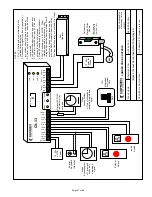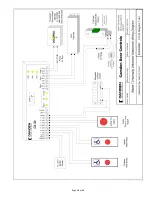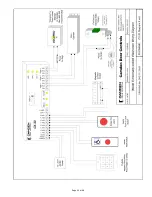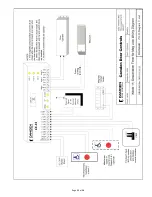
Page 7 of 28
CX-33 Advanced Logic Relay Installation Instructions
Section 3L
Mag Lock with N.O. Fire Alarm
(Mode 11)
Commonly seen in hospital corridors, this version of a
switching network (make/break relay) is specifically designed
for doors with mag locks.
A wall switch signals the relay, which unlocks, and opens the
door for an adjustable time. Utilizing the door position switch,
the CX-33 will not re-apply power to the magnetic lock until
the door is fully closed. The relay also provides for a normally
open Fire Alarm input, which when activated, unlocks the
door and disables the wall switch inputs.
Refer to
Diagram 11
, (Page 22) for the following
connections:
Momentary switches connect to DRY 1 and/or WET terminals.
Maintained devices connect to DRY 2 input (optional). The N.O.
Fire Alarm signal is wired to DRY 3 input, and the Door Position
Switch connects to DRY 4 input. The circuit must be closed
when the door is closed, and open when the door opens.
The magnetic lock connects to the Common and N.C terminals
of Relay 1. The door operator connects to the Common and
N.O. terminals of Relay 2. Relay 3 output is optional.
Once input and output connections are made, program the
unit according to the General Programming Instructions on
page 1, and walk-test the installation. Timing adjustments
may need to be made.
It is NOT recommended to add the “Delay-on-activate”
(or nuisance delay) feature in this mode!
Once the desired operation is achieved, proceed to Section
4, Pg 9 for
System Inspection Instructions
.
Section 3M
Mag Lock with N.C. Fire Alarm
(Mode 12)
This mode is identical to Mode 11 (Section 3L) except the
Fire Alarm input is a N.C. circuit (rather than N.O.). See
previous section for wiring and adjustments, & refer to
Diagram 12
, (Page 23).
Section 3N
Special Purpose Sequencer
(Mode 13)
In this mode, Input 1 sequences Relays 1 & 2, Input 2
sequences Relays 2 & 3. Input 3 sequences Relays
Section 3K
Low Energy SAM Plus
(Mode 10)
This mode combines a Low-Energy Secondary Activation
Module (SAM) with a switching network (aka make/break
relay). Utilizing a door position switch input, this mode
enables or disables a door mounted presence sensor. The
sensor is put into the circuit when a wall switch is pressed
(a Knowing Act). This allows an object or person in the path
of the door to be detected. The door will not close until the
object or person leaves the door swing path. The sensor
remains in the circuit until the door is closed.
When the door is opened manually, the safety sensor is not
in the circuit and the door operator functions as a manual
door closer.
A unique feature of the CX-33 is the automatic reset feature.
If a switch has been pressed, but the door has not opened
within 60 seconds (because it is locked, for instance), the unit
will reset. This will save wear and tear on the lock and operator.
In addition, one input and two relays are provided for the
switching network function.
Refer to
Diagram 10
, (Page 21) for the following connections.
SAM Circuit:
Connect the momentary activating switch(es) to DRY 3 input.
The door mounted sensor connects to DRY 2 input, and the
magnetic contact switch connects to DRY 4 input. The contact
switch circuit must be closed when the door is closed, and
open when the door opens.
Relay 3 output is to be connected to the Activate circuit of the
door operator.
Optional Switching Network:
Wire the activating device(s) to DRY 1 terminals. Wire the
outputs as shown to Relays 1 & 2.
Once input and output connections are made, program the
unit according to the General Programming Instructions on
page 1, and walk-test the installation. Timing adjustments
may need to be made.
It is NOT recommended to add the “Delay-on-activate”
(or nuisance delay) feature in this mode!
Once the desired operation is achieved, proceed to Section 4,
Pg 9 for
System Inspection Instructions
.
CX-33 Advanced Logic Relay Installation Instructions
Summary of Contents for CX-33
Page 10: ...Page 10 of 28...
Page 11: ...Page 11 of 28...
Page 12: ...Page 12 of 28...
Page 13: ...Page 13 of 28...
Page 14: ...Page 14 of 28...
Page 18: ...Page 18 of 28...
Page 19: ...Page 19 of 28...
Page 20: ...Page 20 of 28...
Page 21: ...Page 21 of 28...
Page 22: ...Page 22 of 28...
Page 23: ...Page 23 of 28...








































